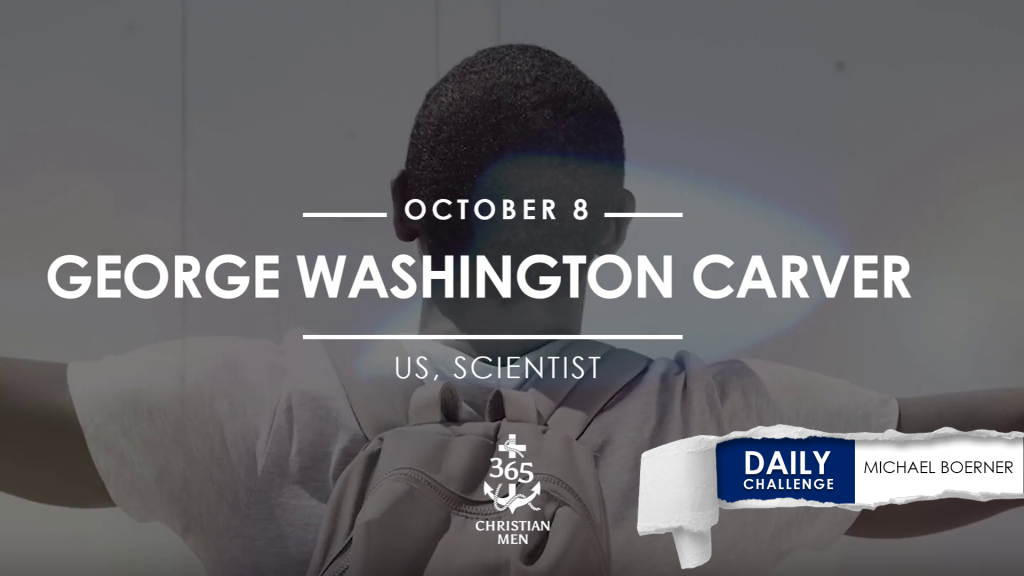October 8. George Washington Carver. Carver was an American professor, agricultural scientist, and inventor. When he was young, he was known as “the plant doctor.” He told about when he was a young boy and said, “Often … people … would say to me, ‘George, my fern is sick. See what you can do with it.’… At this time I had never heard of botany and could scarcely read.” But he got the plants healthy again.
Carver went on to invent many important things, including 300 peanut-related products, but sought only three patents. He actively promoted alternative crops to cotton and methods to prevent soil depletion. He appeared before the House Ways and Means Committee and provided vital information that well served southern farmers. Carver was the most prominent Black scientist of the early 20th century.
He connected with Booker T Washington, Henry Ford, President Franklin Roosevelt, and Mahatma Gandhi. And when Thomas Edison offered Carver a six-figure job, Carver turned it down. And on this date, in 1896, he arrived to teach at Tuskegee Normal and Industrial Institute—and nobody was talking about six figures.
The true measure of a man’s success is found in his willingness to serve others.
Carver stared at the invitation to join the faculty of the Tuskegee Normal and Industrial Institute in Alabama. It was the first major educational institution in the South to hire Black faculty, and its goal was to develop Black leaders. But Carver had no desire to return to the South.
He re-read Booker T. Washington’s letter. “I cannot offer you money, position, or fame.… These things I now ask you to give up. I offer you in their place: work—hard, hard work, the task of bringing a people from degradation, poverty, and waste to full manhood. Your department exists only on paper, and your laboratory will have to be in your head.”
Carver had fought hard to get where he was: the first Black man to earn a master’s degree from Iowa State College. And he now served on its faculty—the first Black college instructor in the whole state of Iowa. He had overcome isolation, hunger, and discrimination and struggled for years to gain acceptance based on his achievements, not the color of his skin.
But the invitation haunted him. He thought about a Scripture he had loved even before he could read, one his foster-mother Susan Carver had taught him. “And ye shall know the truth, and the truth shall make you free” (John 8:32).
The students of Tuskegee Institute, just one generation from slavery, were technically free, but society—and the students’ own perceptions—held them back. Who would teach them that, as God’s treasured creations, they were free to dream? Who saw and encouraged their talents? Their curiosity? Carver sensed God’s call to Tuskegee. This decision wasn’t only about logic. It was also about living out his faith in service to God and others. This was the true measure of success.
Carver accepted the new job, where he employed all the knowledge he had gained, not only in his education, but also in his years of struggle.
He turned a swamp into an agricultural-testing site and developed a lab from items he had found in trash heaps. He conducted experiments on top of teaching science and agriculture; he also taught weekly Bible studies. He wanted his students to see themselves as valued children full of potential—potential that, when surrendered to their Creator, could take them beyond their dreams and help them serve others.
Farmers—both Black and white—succeeded using Carver’s methods. He taught crop rotation and explained that planting sweet potatoes and legumes—like peanuts—would return needed nutrients to worn-out cotton fields.
When the farmers didn’t know what to do with the peanuts they grew, Carver developed more than 300 uses for them. When he had arrived at Tuskegee in 1896, the peanut was not a recognized US crop, but by 1940, it had become one of the six leading crops in the nation. To better serve farmers, Carver designed a traveling classroom in a wagon, so representatives from Tuskegee could go directly to the farms.
Though Booker had not promised him fame, fame came to Carver anyway. By 1905, most people in America and across the world knew the name George Washington Carver. (He took Booker’s last name for his middle name.)
As Carver’s success grew, people sometimes urged him to update his lifestyle—including his wardrobe and living arrangements—but Carver told them it didn’t matter how much money people had in the bank or what type of automobile they drove. “These mean nothing,” he said. “It is simply service that measures success.”
How do you measure success? The true measure of a man’s success is found in his willingness to serve others.
O’Connor, Allison. “Tuskegee University (1881- ).” Blackpast. Published October 27, 2009. https://blackpast.org/aah/tuskegee-university-1881.
Collins, Ace. Stories Behind Men of Faith. Grand Rapids: Zondervan, 2009. Chapter Seven.
“George Washington Carver.” Science History Institute. Updated December 4, 2017. https://www.sciencehistory.org/historical-profile/george-washington-carver.
Would You Like to Learn More About This Man?
Want to share Carver’s story with your children or grandchildren? See George Washington Carver by Andy Carter and Carol Saller (Millbrook Press, 2001).
Story read by: Daniel Carpenter
Introduction read by: Daniel Carpenter
Audio production: Joel Carpenter
Editor: Teresa Crumpton, https://authorspark.org/
Project manager: Blake Mattocks
© 2020, 365 Christian Men, LLC. All rights reserved.





